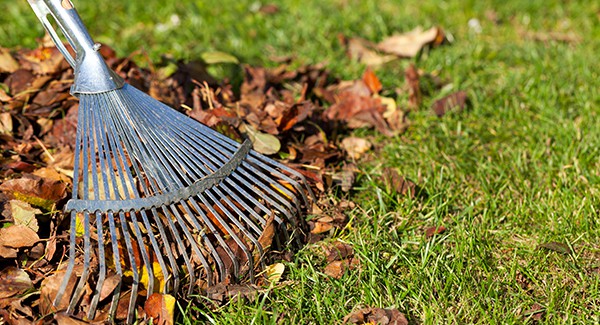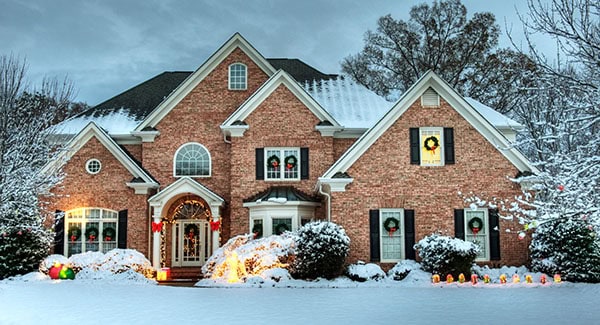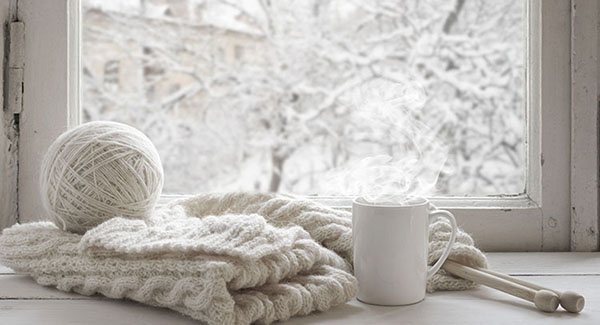
Last Updated on October 30, 2025
As soon as brightly colored leaves start to blanket yards, many homeowners start to dread the falling foliage because it usually means one thing: It’s time to dust off the rake. Not sure what to do with the mounds and mounds of leaves taking up residence on your lawn? Try these suggestions.
Leaf removal tips
Use a tarp
If your aversion to raking is pretty strong, consider using a brown tarp to do the heavy lifting. Just don’t leave the tarp out for too long, as it will likely kill your grass and annoy your neighbors!
Mow
Looking to knock two things off your to-do list at once? Get rid of leaves when you use the bag attachment on your mower. Make sure to clear up any fallen twigs first, as those can easily be hidden under the leaf covering. Set a reminder to mow your yard about once a week during the fall; doing so will ensure all leaves are gone once winter strikes. And because leaves are a natural (and free) fertilizer, using this method will not only save your back but provide for a much healthier lawn next spring and summer.
Leaf blower
If you have a larger yard, a leaf blower is your best bet for quickly and easily cleaning up the debris. Don’t have a leaf blower? Keep your ears open for a neighbor who might be using one, and bake them a fall dessert in exchange for borrowing their equipment.
Leaf recycling tips
Mulch
Did you know that fallen leaves double as mulch? Homeowners might be surprised to find out that leaves actually function just as good (if not better), than the best store-bought mulch. For best results, chop up fallen leaves as fine as possible using a leaf shredder or by simply running the lawn mower over the leaves several times. Bag up the scraps and save for your springtime gardening efforts. And if you keep a few bags of leaf mulch around long enough—usually 1 to 3 years—you’ll have leaf mold. Leaf mold is a gardener’s secret weapon, as it is high in calcium and magnesium, helps to retain moisture in soil, and in hot temperatures, helps cool roots and foliage.
Cold-weather covering
An intense cold snap can quickly kill delicate plants in the winter. Save your cold-weather curb appeal! Shield greenery from the cold this winter when you insulate them with a bed of shredded leaves. The covering must be at least six inches deep to work efficiently as a safeguard against the freezing temps.
Compost
Ground up leaves are an integral addition to your compost pile. Make a compost lasagna by alternating layers of shredded leaves with your green clippings and let it sit through winter. When spring planting time rolls around, your compost will be complete. Consider saving a couple bags of leaves for your spring compost—a time when leaves are few and far between.
Leaf it be
Leaves are nature’s winter blanket for your lawn. Savvy gardeners understand that leaving fallen leaves where they lie through the winter months is a win-win. Leaves provide insulation and moisture retention to your lawn. A thin layer of leaves adds nutrients back to the soil, reducing the need for store-bought lawn-care products in the spring. In the meantime, leaf litter provides food and shelter for a variety of critters in your yard, including beneficial insects, salamanders, and eastern box turtles.
Howard Hanna Allen Tate Real Estate is the #1 real estate company in the Carolinas, with more than 80 offices and 1,800 agents serving communities across North and South Carolina and Georgia. As part of Howard Hanna Real Estate Services, the largest family-owned and operated real estate company in the United States, Howard Hanna Allen Tate offers a full suite of real estate services, including mortgage, insurance, title, and relocation.
For more information, visit howardhannatate.com.



